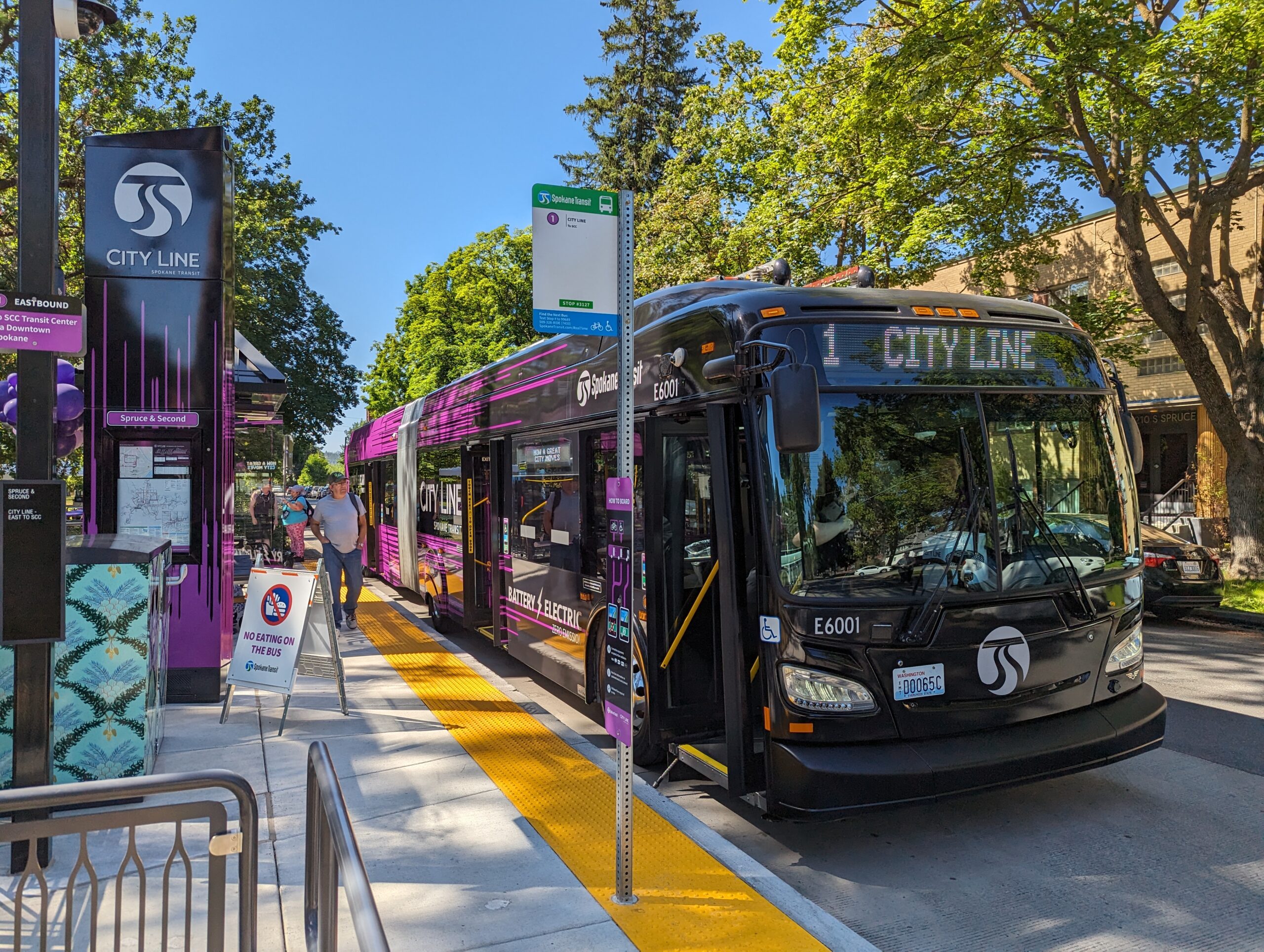Yesterday, in a blazing July morning, hundreds of people gathered in Coeur d’Alene Park with dogs, rider passports, backpacks emblazoned with the STA logo, and neon-colored shaved ice to witness the inauguration of services for Spokane’s biggest public transit project in years: the City Line Bus Rapid Transit service, the first of its kind in Spokane, and even the larger Inland Northwest.
The service is a six-mile long bus rapid transit line that begins in Browne’s Addition, a historic neighborhood near Spokane’s Downtown area, and winds through downtown and the Gonzaga University District, all the way to Spokane Falls Community College. The route is promoted as a form of transit one “doesn’t need a schedule for,” because during peak hours a bus arrives every fifteen minutes. (The intervals lengthen to thirty minutes on Sundays.)
It is the first BRT line in the Inland Northwest.
Each City Line stop, illuminated with local art, features a screen displaying the next available bus times, down to the minute. Each bus holds approximately ninety passengers, with dedicated sections for those with bicycles or mobility aids.
And, critically, the line features an all-electric, zero-emission fleet of buses that also emit very little noise pollution. (I can confirm they’re impressively quiet!)
Spokane transit officials believe the new BRT line will positively influence the city’s economy and future development. They point to a 2014 economic study, which estimates that “over a twenty-year period the projected increase to surrounding land and improvements values will increase by $175 million.”
The genesis of the project began in 2005, when the Spokane Transit Authority (STA) began exploring an old proposal for a revitalized public transit system that resembled the streetcar models of old Spokane. Originally, the idea was to feature an electric trolley line in lieu of building a fixed guideway.
However, after contemplating the costs of building streetcar tracks, the STA decided in the 2010s to pursue building a bus rapid transit line instead, and eventually made it to the construction phase.
Despite some economic setbacks and delays, including the failure of a ballot measure in 2015 that would have granted STA more funding and supply chain shortages during the pandemic, the project has moved along. Earlier this year, STA invited the public to participate in a simulated trial run to gather feedback. And finally, on July 15th, the City Line made its inaugural run!
Spokane celebrated the launch with a multi-stop celebration featuring food, performances from local bands, games, and, of course, plenty of purple City Line-themed souvenirs and treats. (The author’s favorite were some sugar cookies from Three Birdies Bakery, beautifully decorated with images of one of the City Line buses.) Riders could participate in a punch-card game in which they could collect a commemoarative stamp from each transit stop hosting a celebration; the first one hundred riders to present all five punches received a prize.
For those without a car, City Line is a really big deal.
The lack of a vehicle can be an extraordinary barrier to participating in social and economic life. For those who are disabled, single with children, elderly, low-income, or have legal restrictions that prevent them from obtaining a driver’s license, those barriers can compound. Inadequate public transit can turn the simplest of errands into whole-day affairs… to say nothing of the environmental damage America’s overreliance on automobiles has caused.
Portland, Vancouver B.C., and Seattle have all made significant investments in rail transit to improve mobility in recent years. Portland’s MAX system now consists of nearly sixty miles of track, and Seattle’s 1 Line will soon be extended north and south, with a 2 Line also opening up to connect the Emerald City to its eastern suburbs. Spokane has been slow to follow suit. But this new City Line signifies the Lilac City is ready to join the twenty-first century. City Line will make working, living, and going to school easier for tens of thousands of Spokane residents and visitors – and leaving a smaller environmental footprint while they’re at it!
For a limited time, riders can enjoy riding on the City Line at no cost through the beginning of September. That’s right, no fares required, just hop on board!
Hopefully, this will only be the beginning of Spokane’s investment in high capacity transit for sall Congratulations to STA, their employees, grant funders, and all the construction crews who helped make this possible!

